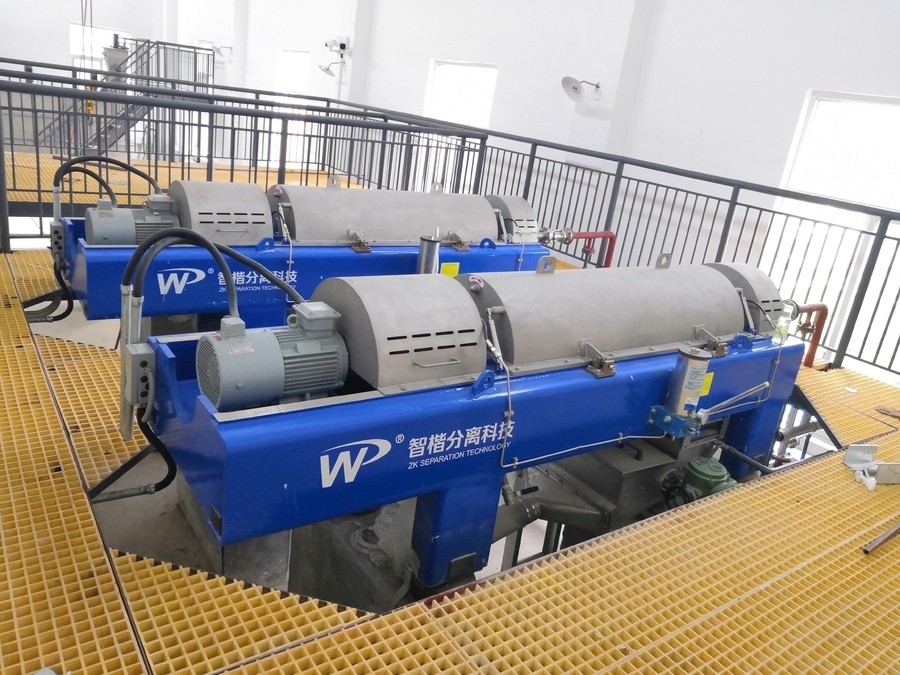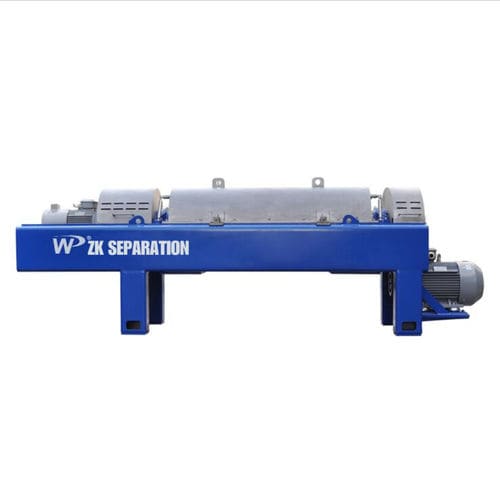
#White Papers
Comparison between Decanter Centrifuge and Filter Press for Sludge Thickening
The advantage and disadvantage of different dewatering equipment
Companies often hesitate between different equipment when choosing sludge thickening equipment, so this article compares two of the most popular sludge dewatering equipment - Decanter centrifuge and Filter Press - on the market for companies to choose from.
Sludge Thickening
Sludge thickening is a process in which the solids concentration is increased and the total sludge volume is correspondingly decreased, but the sludge still behaves like a liquid instead of a solid.
A procedure used to increase the solids content of sludge by removing a portion of the liquid fraction
This volume reduction, obtained by sludge thickening or sludge concentration, is done for the following purposes:
To permit increased loadings to sludge digesters
To increase feed solids concentration to vacuum filters
To economize on transport costs as in ocean barging in case of raw sludge
To minimize the land requirements as well as handling costs when digested sludge has to be transported to a disposal site
To save on the auxiliary fuel that may otherwise be needed when digested when incineration of sludge is practiced
Methods of Sludge Thickening
Sludge thickening is commonly achieved by the following three methods:
1. Gravity thickening
2. Air flotation
3. Centrifugation
a) Gravity Thickening
Gravity thickening increases the solids concentration by allowing the particles to settle to the base of a vessel, producing a concentrated (thickened) solids stream at the vessel base and a supernatant (diluted) stream at the surface.
b) Flotation Thickening
Dissolved air flotation (DAF) provides thickening of sludge by encouraging the solids to float to the surface, rather than allowing them to sink to the tank base as with gravity thickening, where they can be removed by a skimmer. DAF is applied when the sludge solids are neutrally buoyant (i.e. neither sink nor float) and so cannot be readily removed by conventional settling.
c) Centrifugal Thickening
Centrifugal thickening increases the sludge concentration (i.e. thickens the sludge) by encouraging the particles to migrate to the walls of a rapidly rotating cylindrical vessel under the influence of a centrifugal force.
However, in order to meet the requirements of high treatment capacity, small footprint, and low energy consumption, the choice is usually made between the following three types of equipment:
I. Decanter Centrifuge
A decanter centrifuge works by exerting a high centrifugal force on the slurry of solids and liquids. A rotating conveyor pushes out the heavier solids that settle on the decanter wall. The lighter liquid exits the decanter through the liquid outlet port on the other end of the bowl.
Advantages:
1. Hygienic and easy to operate
2. No or less chemical substances are needed
3. Low total processing cost and a high degree of automation
4. low investment in infrastructure, small footprint, compact equipment structure
5. Large treatment capacity and the water content of the sludge cake is comparable to that of the belt filter press
Disadvantages:
1. Higher power consumption, vibration, and noise
2. High requirements for the material pretreatment process
3. High maintenance cost
II. Belt Filter Press
A belt filter press (BFP) provides sludge dewatering by pressing the sludge to force the water through a permeable medium.
Advantages:
1. Lower energy consumption
2. Continuous operation and easy management
3. The water content of the sludge cake is relatively low
Disadvantages:
1. Larger footprint
2. Not suitable for organic sludge
3. Harsh working environment - The equipment is poorly sealed
4. Complex Structure - Need to use the air compressor and other auxiliary equipment
5. High maintenance cost - If there are sharp impurities in the sludge, it is very easy to damage the filter belt, which is expensive.
6. After the operation, the filter belt needs to be cleaned with a large amount of water at high pressure, which causes secondary pollution.
III. Plate and Frame Type Filter Press
The working principle of plate and frame type filter presses is that slurry is pumped into the machine such that solids are distributed evenly during the filling cycle. Solids build up on the filter cloth, forming the filter cake; the filtrate exits the filter plates through the corner ports into the manifold, yielding clean filtered water.
Advantages:
1. Very low water content of sludge cake
Disadvantages:
1. Low automation
2. Not suitable for organic sludge
3. When the sludge content is below 2%, the efficiency is lower.
4. High power feed pump, fast wear and tear of machine and equipment, high cost.
5. High maintenance cost - The power part of this equipment is hydraulic equipment.
6. When the sludge viscosity is high, the separation effect will be poor and the filter cloth needs to be replaced in a short period of time, which is costly.
To sum up, the decanter centrifuge will be more cost-effective in comparison, but the filter press also has advantages in solid-phase water content. If you care more about flexibility and high capacity, a decanter is a good choice, and if you have enough space and want drier solids then you may choose filter presses. All in all, companies should decide according to the actual situation when making the choice.





